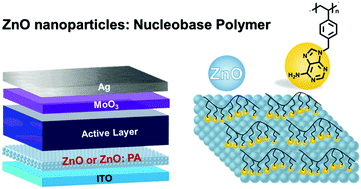Adenine-based polymer modified zinc oxide for efficient inverted organic solar cells†
Abstract
Inverted organic solar cells (OSCs) containing high work-function metal anodes (e.g., Ag or Au) and modified indium tin oxide (ITO) cathodes are more compatible with large area printing technique and exhibit superior stability. Zinc oxide (ZnO) nanoparticles are widely used as cathode interlayer materials in inverted OSCs. However, low temperature processed ZnO nanoparticle films always have large amount of defect states, decreasing the device efficiency and stability. In this manuscript, a nucleobase adenine (A)-based polymer (PA) was synthesized through reversible addition–fragmentation chain transfer (RAFT) polymerization. PA works as an efficient modifier to passivate the defects, improve the conductivity, and reduce the work function (WF) of the ZnO nanoparticle films. The resultant organic–inorganic hybrid composite shows strong power on interfacial modification and energy level alignment at the device interface. The modification of ZnO nanoparticle interlayers with PA can efficiently suppress the charge recombination, and reduce the Schottky barriers of solar cell devices, affording high performance fullerene- and non-fullerene-based OSCs over a wide interlayer thickness range, from ∼18 nm to ∼100 nm. Devices containing ZnO nanoparticle interlayers modified with an optimal PA weight ratio (∼25%) yielded a maximum efficiency of 16.2%, which is among the highest efficiencies reported for inverted OSCs with the non-fullerene active layer.

- This article is part of the themed collection: Journal of Materials Chemistry C Emerging Investigators


 Please wait while we load your content...
Please wait while we load your content...